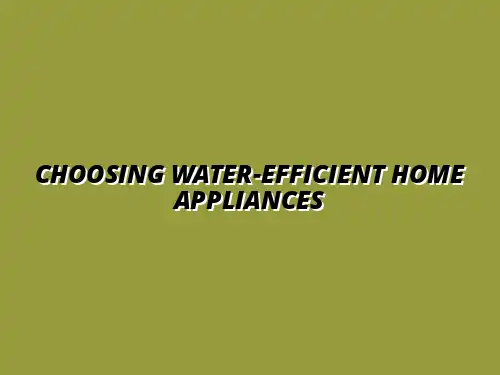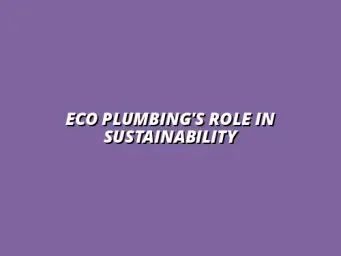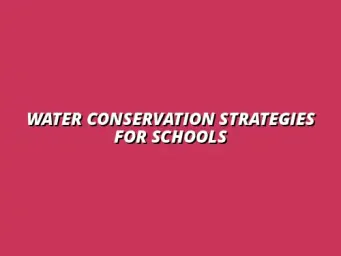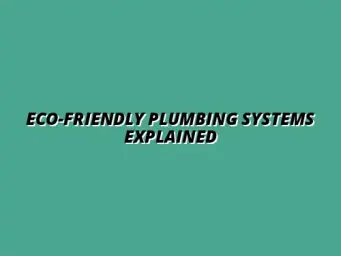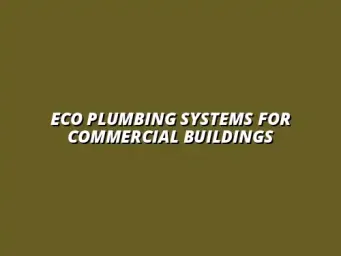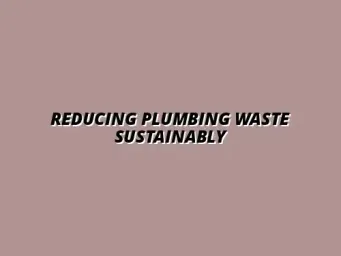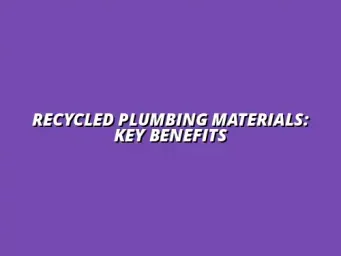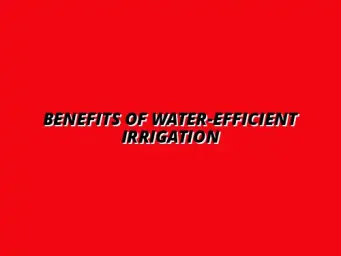Understanding Water Efficiency and Its Importance
Water efficiency is all about using water wisely and minimizing waste. In our world where water is a precious resource, understanding how to use it efficiently is crucial. Implementing water-saving practices can lead not only to environmental benefits but also to significant savings in your utility bills! For more practical tips on saving water at home, check out these water-saving tips.
Defining Water-Efficient Appliances
Water-efficient appliances are specially designed to use less water while still providing high performance. These include devices such as dishwashers, washing machines, and toilets that meet specific standards for water usage. By choosing these appliances, you can conserve water without compromising on quality! Upgrading your kitchen faucet can also contribute to water savings; learn how to install a new kitchen faucet quickly and easily.
- Dishwashers: Use less water per load compared to hand washing.
- Washing Machines: Designed to clean clothes effectively with less water.
- Toilets: Use a smaller amount of water per flush.
The Environmental and Economic Benefits of Water Conservation
Conserving water has both environmental and economic benefits. From an environmental perspective, using less water helps to preserve our natural resources and protect local ecosystems. Efficient irrigation systems can significantly impact water conservation; discover the benefits of water-efficient irrigation. Economically, reducing water usage can significantly lower your water bills!
- Lower utility bills: Save money each month by using less water.
- Reduced energy costs: Less water usage often means lower energy consumption.
- Less strain on local water supplies: Helps to ensure availability for future generations.
Key Factors to Consider When Choosing Water-Efficient Appliances
When selecting water-efficient appliances, it's important to look at various factors to ensure you're making the best choice for your home. Understanding how these appliances work and their ratings can guide you in selecting the right options for your needs. Plus, it can lead to long-term savings and sustainability! Regular bathroom plumbing maintenance is also crucial for preventing water waste and costly repairs; find helpful tips on essential bathroom plumbing maintenance.
Understanding Water Usage Ratings and Standards
Water usage ratings provide insights into how much water an appliance consumes during its operation. Familiarizing yourself with these ratings helps you compare products effectively. Different standards and certifications can help you identify the most efficient options available.
- Gallons per load: How much water the appliance uses for each cycle.
- Daily average usage: Estimated water consumption based on typical usage.
- Efficiency ratings: Ratings that indicate the appliance's performance in water conservation.
Energy Star Certification and Its Relevance
Energy Star certification is a mark of energy efficiency that many appliances carry. While it's primarily focused on energy use, many Energy Star appliances also help reduce water consumption. This certification is a good sign that you're choosing a product that benefits both your wallet and the environment!
WaterSense Label: What It Means for Consumers
The WaterSense label identifies products that meet water efficiency guidelines set by the U.S. Environmental Protection Agency. Appliances with this label can help you save water without sacrificing performance. When you see this label, you can be confident that you're making a responsible choice!
Assessing Household Water Needs and Patterns
Before purchasing water-efficient appliances, it’s essential to assess your household's water needs. Understanding your daily water usage patterns will help you determine which appliances will save you the most water. This way, you can make informed decisions that align with your lifestyle! For homes in Tyseley, Birmingham, consider contacting a local plumber for assistance with water-efficient installations. Find a reliable plumber here.
Calculating Daily Water Usage for Different Household Appliances
To get a clearer picture of your water needs, start by calculating how much water each appliance uses daily. Here’s a simple way to do it:
- Dishwasher: Estimate gallons used per load multiplied by loads per day.
- Washing Machine: Multiply the gallons used per load by the number of loads.
- Showerheads: Assess gallons per minute and average shower time.
Identifying High-Water-Usage Areas in Your Home
Next, pinpoint areas in your home where water usage is highest. This helps in deciding which appliances to upgrade or replace for maximum efficiency. Common high-water-usage areas include:
- Kitchen: Dishwashers and sinks.
- Bathroom: Toilets, showers, and faucets.
- Laundry Room: Washing machines.
Types of Water-Efficient Appliances Available
There are several types of water-efficient appliances that can help you conserve water. Each type offers unique features designed to reduce consumption while maintaining performance. By understanding these options, you can better evaluate what works for your home! Investing in water-saving fixtures can make a big difference in your home's overall water efficiency. Explore options for water-saving fixtures for green homes.
Water-Saving Dishwashers: Features to Look For
When shopping for a water-saving dishwasher, consider features that enhance efficiency. Look for models that offer:
- Soil sensors: Adjust the wash cycle based on the dirtiness of dishes.
- Eco modes: Use less water and energy for lighter loads.
- Compact sizes: Ideal for small households with fewer dishes.
High-Efficiency Washing Machines and Their Benefits
High-efficiency washing machines are designed to use significantly less water than traditional models. They achieve this through innovative technology that optimizes water flow. Benefits include:
- Less water per load: Save gallons with each wash.
- Faster drying times: Spin cycles extract more water for quicker drying.
- Gentler on clothes: Use less water and energy while preserving fabric quality.
Low-Flow Toilets and Showerheads: Making the Right Choices
Low-flow toilets and showerheads can have a significant impact on your water usage. When choosing these fixtures, consider features like:
- Dual flush options: Choose between low and high water usage for different needs.
- Flow rate: Measured in gallons per minute for showerheads.
- Comfort height toilets: Designed for ease of use and efficiency.
By understanding your options and the benefits of water-efficient appliances, you can make choices that not only help the environment but also save you money in the long run! Prevent scale buildup in your water heater to ensure its efficiency and longevity. Learn how to prevent scale buildup.
Addressing Common Questions About Water-Efficient Appliances
When considering water-efficient appliances, you likely have questions about their benefits and functionalities. This section aims to address some of the most common inquiries that homeowners have before making a purchase. Understanding these aspects can help you make informed decisions that not only save water but also reduce monthly utility bills.
One question that comes up often is about the savings associated with investing in water-efficient appliances. By knowing what to expect, you can better assess the value these appliances bring to your home.
How Much Can I Save with Water-Efficient Appliances?
Water-efficient appliances can significantly lower your water bills and contribute to sustainability. The amount you save can vary based on several factors, including the types of appliances you replace and your household’s water usage patterns. However, many consumers report substantial annual savings.
- The average household can save up to 30% on water bills by switching to water-efficient appliances.
- Replacing a standard toilet with a low-flow model may save you 13,000 gallons of water annually.
- Water-saving dishwashers and washing machines can reduce water usage by up to 50% compared to older models.
These savings not only help your wallet but also positively impact our planet by conserving water resources. With these figures in mind, you can see the value behind choosing water-efficient appliances!
Can I Retrofit Existing Appliances to Improve Water Efficiency?
Many homeowners wonder if they can improve the water efficiency of their current appliances instead of replacing them altogether. Retrofitting can be a practical solution, allowing you to enhance performance without incurring the costs of new appliances. Here’s what to consider:
- Install low-flow showerheads and faucet aerators to reduce water usage.
- Consider a dual-flush mechanism for toilets to save water with every flush.
- Upgrade dishwashers with water-efficient settings and options, if available.
Retrofitting can lead to improved efficiency, but it’s essential to ensure compatibility with your existing appliances. Always consult a professional if you’re unsure about the modifications!
Final Thoughts on Selecting Water-Efficient Appliances for Your Home
Choosing water-efficient appliances is a great step toward creating a sustainable home. As you consider your options, it’s important to think about the bigger picture of water conservation and environmental impact. Every small change can influence community practices and lead to better resource management.
Creating a Sustainable Home: The Bigger Picture
Incorporating water-efficient appliances is just one aspect of building a sustainable home. It’s crucial to think of your entire home ecosystem, including energy usage and waste management. By aligning all these elements, you contribute to a healthier planet.
- Start by setting a water conservation goal for your household.
- Monitor your water usage regularly to track improvements.
- Share tips and strategies with friends and family to encourage broader community efforts.
By adopting these practices, you can inspire change in your community and promote a culture of conservation. It’s all about making conscious choices that benefit everyone!
Encouraging Family and Community Water Conservation Practices
Once you’ve made changes in your home, it’s time to get your family and community involved in water conservation. Educating others about the importance of saving water can create a ripple effect, leading to better resource management at all levels.
- Host discussions about water conservation at home or in community centers.
- Engage in local conservation programs or initiatives that aim to educate others.
- Share your successes with friends and neighbors to motivate them to follow suit.
Everyone plays a role in conserving our planet’s precious water supply, and together, we can make a significant impact! Small steps lead to big changes, and your journey to sustainability can inspire others to join the cause.

